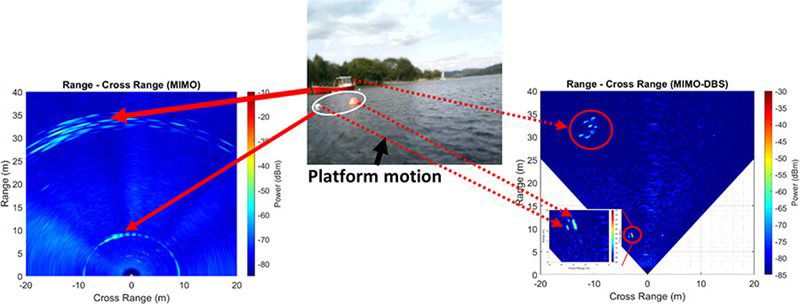One SAR based technique developed and patented by the researchers in MISL is Doppler beam sharpening (DBS), a form of unfocussed SAR, straightforwardly implemented on a range-Doppler map. DBS maps the measured Doppler frequency of a target to its angular position; thus, a wide real azimuth beam is sub-divided into smaller sub-beams.
 Fig 6. Image of a floating pallet formed through application of DBS (0.5s integration time), with 14 overlaid coherently processed DBS images. 150 GHz radar platform moving along a jetty at Coniston Water in the Lake District, UK.
Fig 6. Image of a floating pallet formed through application of DBS (0.5s integration time), with 14 overlaid coherently processed DBS images. 150 GHz radar platform moving along a jetty at Coniston Water in the Lake District, UK.
DBS has been successfully implemented in automotive and maritime environments using commercially available mm-wave automotive MIMO sensors and a sub-THz sensor suite developed at MISL.
By combining DBS with a traditional MIMO beamformer, high sidelobes due to equivalent one-way propagation effect of the MIMO beamformer have been significantly suppressed whilst improving the cross-range resolution. Additionally, the full structure of targets is also visible that is otherwise not identifiable with MIMO imagery.
 Fig 7. Image of a boat and buoys formed through the applicaiton of MIMO and MIMO-DBS (128ms integration time) 77 GHz forward-looking radar platform moving at 9m/s at Coniston Water in the Lake District, UK.
Fig 7. Image of a boat and buoys formed through the applicaiton of MIMO and MIMO-DBS (128ms integration time) 77 GHz forward-looking radar platform moving at 9m/s at Coniston Water in the Lake District, UK.
MIMO-DBS beamforming when combined with accurate estimates of platform dynamics (position, velocity, heading) is useful to locate and track targets in world coordinates. This will be particularly useful for scene reconstruction and path planning and is the current focus of this work.